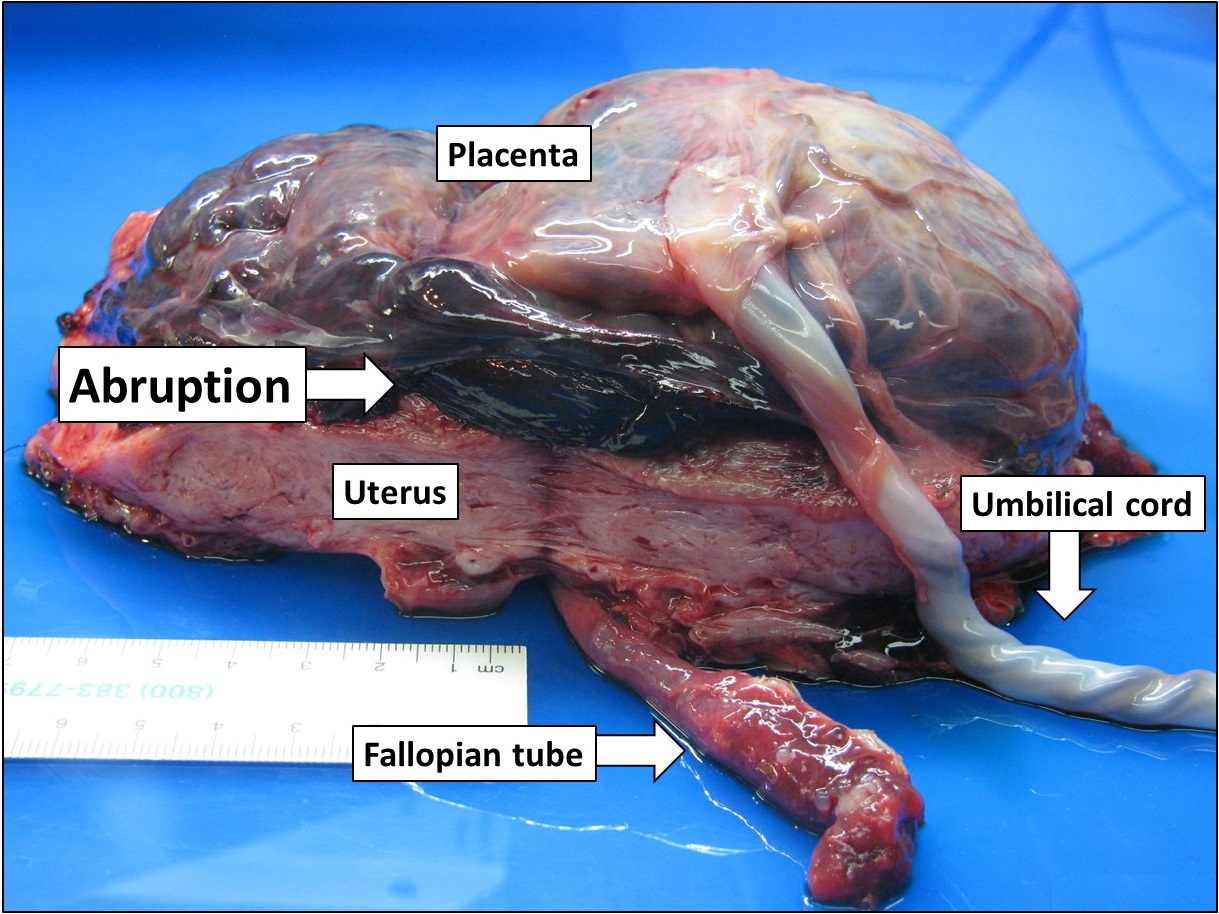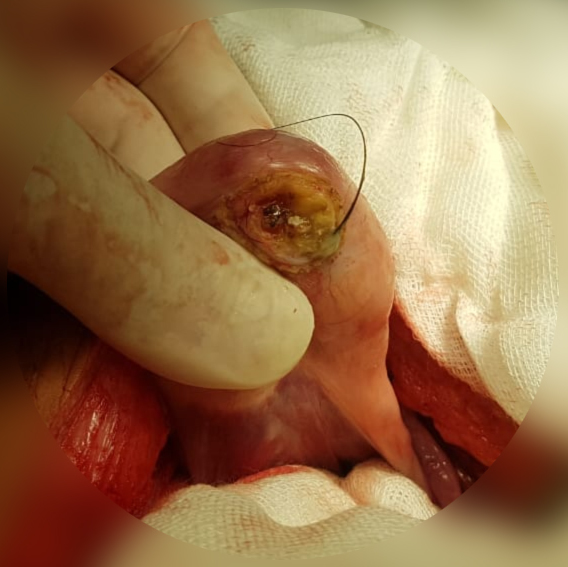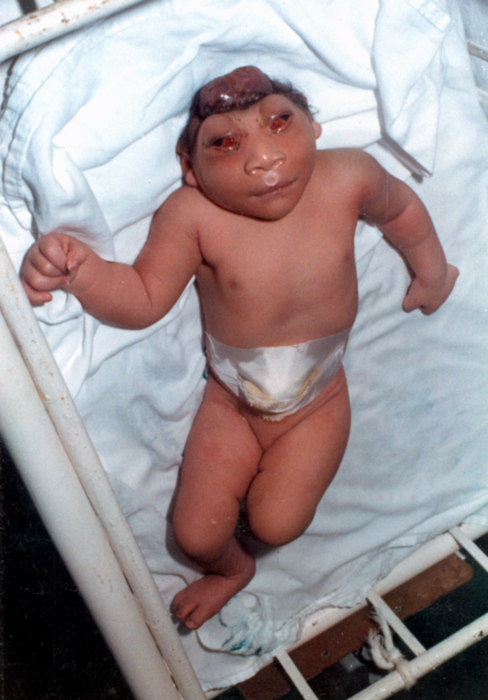|
Polyhydramnios
Polyhydramnios is a medical condition describing an excess of amniotic fluid in the amniotic sac. It is seen in about 1% of pregnancies. It is typically diagnosed when the amniotic fluid index (AFI) is greater than 24 cm. There are two clinical varieties of polyhydramnios: chronic polyhydramnios where excess amniotic fluid accumulates gradually, and acute polyhydramnios where excess amniotic fluid collects rapidly. The opposite to polyhydramnios is oligohydramnios, not enough amniotic fluid. Presentation Associated conditions Fetuses with polyhydramnios are at risk for a number of other problems including cord prolapse, placental abruption, premature birth and perinatal death. At delivery the baby should be checked for congenital abnormalities. Causes In most cases, the exact cause cannot be identified. A single case may have one or more causes, including intrauterine infection (TORCH), rh-isoimmunisation, or chorioangioma of the placenta. In a multiple gestation pregna ... [...More Info...] [...Related Items...] OR: [Wikipedia] [Google] [Baidu] |
Amniotic Fluid Index
Amniotic fluid index (AFI) is a quantitative estimate of amniotic fluid and an indicator of fetal well-being. It is a separate measurement from the biophysical profile. AFI is the score (expressed in cm) given to the amount of amniotic fluid seen on ultrasonography of a pregnant uterus. To determine the AFI, doctors may use a four-quadrant technique, when the deepest, unobstructed, vertical length of each pocket of fluid is measured in each quadrant and then added up to the others, or the so-called "Single Deepest Pocket" technique. An AFI between 8–18 is considered normal. Median AFI level is approximately 14 from week 20 to week 35, when the amniotic fluid begins to reduce in preparation for birth. An AFI 24–25 is considered as polyhydramnios. Causes of low amniotic fluid There are many things that can cause low AFI, these include: * Leaking or rupture of membranes: Leaking or rupture of membranes may be caused by a gush of fluid or a slow constant trickle of fluid. This ... [...More Info...] [...Related Items...] OR: [Wikipedia] [Google] [Baidu] |
Placental Abruption
Placental abruption is when the placenta separates early from the uterus, in other words separates before childbirth. It occurs most commonly around 25 weeks of pregnancy. Symptoms may include vaginal bleeding, lower abdominal pain, and dangerously low blood pressure. Complications for the mother can include disseminated intravascular coagulopathy and kidney failure. Complications for the baby can include fetal distress, low birthweight, preterm delivery, and stillbirth. The cause of placental abruption is not entirely clear. Risk factors include smoking, pre-eclampsia, prior abruption (most important and predictive risk factor), trauma during pregnancy, cocaine use, and previous cesarean section. Diagnosis is based on symptoms and supported by ultrasound. It is classified as a complication of pregnancy. For small abruption, bed rest may be recommended, while for more significant abruptions or those that occur near term, delivery may be recommended. If everything is stable, ... [...More Info...] [...Related Items...] OR: [Wikipedia] [Google] [Baidu] |
Amniotic Fluid
The amniotic fluid is the protective liquid contained by the amniotic sac of a gravid amniote. This fluid serves as a cushion for the growing fetus, but also serves to facilitate the exchange of nutrients, water, and biochemical products between mother and fetus. For humans, the amniotic fluid is commonly called water or waters (Latin liquor amnii). Development Amniotic fluid is present from the formation of the gestational sac. Amniotic fluid is in the amniotic sac. It is generated from maternal plasma, and passes through the fetal membranes by osmotic and hydrostatic forces. When fetal kidneys begin to function around week 16, fetal urine also contributes to the fluid. In earlier times, it was believed that the amniotic fluid was composed entirely of fetal urine. The fluid is absorbed through the fetal tissue and skin. After 22 to 25 week of pregnancy, keratinization of an embryo's skin occurs. When this process completes around the 25th week, the fluid is primarily absor ... [...More Info...] [...Related Items...] OR: [Wikipedia] [Google] [Baidu] |
Gastrointestinal
The gastrointestinal tract (GI tract, digestive tract, alimentary canal) is the tract or passageway of the digestive system that leads from the mouth to the anus. The GI tract contains all the major organs of the digestive system, in humans and other animals, including the esophagus, stomach, and intestines. Food taken in through the mouth is digested to extract nutrients and absorb energy, and the waste expelled at the anus as feces. ''Gastrointestinal'' is an adjective meaning of or pertaining to the stomach and intestines. Most animals have a "through-gut" or complete digestive tract. Exceptions are more primitive ones: sponges have small pores ( ostia) throughout their body for digestion and a larger dorsal pore (osculum) for excretion, comb jellies have both a ventral mouth and dorsal anal pores, while cnidarians and acoels have a single pore for both digestion and excretion. The human gastrointestinal tract consists of the esophagus, stomach, and intestines, and is div ... [...More Info...] [...Related Items...] OR: [Wikipedia] [Google] [Baidu] |
Nausea
Nausea is a diffuse sensation of unease and discomfort, sometimes perceived as an urge to vomit. While not painful, it can be a debilitating symptom if prolonged and has been described as placing discomfort on the chest, abdomen, or back of the throat. Over 30 definitions of nausea were proposed in a 2011 book on the topic. Nausea is a non-specific symptom, which means that it has many possible causes. Some common causes of nausea are gastroenteritis and other gastrointestinal disorders, food poisoning, motion sickness, dizziness, migraine, fainting, low blood sugar, anxiety, and lack of sleep. Nausea is a side effect of many medications including chemotherapy, or morning sickness in early pregnancy. Nausea may also be caused by disgust and depression. Medications taken to prevent and treat nausea and vomiting are called antiemetics. The most commonly prescribed antiemetics in the US are promethazine, metoclopramide, and the newer ondansetron. The word nausea is from Lat ... [...More Info...] [...Related Items...] OR: [Wikipedia] [Google] [Baidu] |
Antacids
An antacid is a substance which neutralizes stomach acidity and is used to relieve heartburn, indigestion or an upset stomach. Some antacids have been used in the treatment of constipation and diarrhea. Marketed antacids contain salts of aluminum, calcium, magnesium, or sodium. Some preparations contain a combination of two salts, such as magnesium carbonate and aluminium hydroxide (e.g. hydrotalcite). Medical uses Antacids are available over the counter and are taken by mouth to quickly relieve occasional heartburn, the major symptom of gastroesophageal reflux disease and indigestion. Treatment with antacids alone is symptomatic and only justified for minor symptoms.U.S. Department of Health & Human Services. Agency for Healthcare Research and Quality 23 September 201Consumer Summary – Treatment Options for GERD or Acid Reflux Disease: A Review of the Research for Adults Alternative uses for antacids include constipation, diarrhea, hyperphosphatemia, and urinary alkalizatio ... [...More Info...] [...Related Items...] OR: [Wikipedia] [Google] [Baidu] |
Multiple Birth
A multiple birth is the culmination of one multiple pregnancy, wherein the mother gives birth to two or more babies. A term most applicable to vertebrate species, multiple births occur in most kinds of mammals, with varying frequencies. Such births are often named according to the number of offspring, as in ''twins'' and ''triplets''. In non-humans, the whole group may also be referred to as a ''litter'', and multiple births may be more common than single births. Multiple births in humans are the exception and can be exceptionally rare in the largest mammals. A multiple pregnancy may be the result of the fertilization of a single egg that then splits to create identical fetuses, or it may be the result of the fertilization of multiple eggs that create fraternal ("non-identical") fetuses, or it may be a combination of these factors. A multiple pregnancy from a single zygote is called ''monozygotic'', from two zygotes is called ''dizygotic'', or from three or more zygotes is calle ... [...More Info...] [...Related Items...] OR: [Wikipedia] [Google] [Baidu] |
Rh Incompatibility
Hemolytic disease of the newborn, also known as hemolytic disease of the fetus and newborn, HDN, HDFN, or erythroblastosis foetalis, is an alloimmune condition that develops in a fetus at or around birth, when the IgG molecules (one of the five main types of antibodies) produced by the mother pass through the placenta. Among these antibodies are some which attack antigens on the red blood cells in the fetal circulation, breaking down and destroying the cells. The fetus can develop reticulocytosis and anemia. The intensity of this fetal disease ranges from mild to very severe, and fetal death from heart failure (hydrops fetalis) can occur. When the disease is moderate or severe, many erythroblasts (immature red blood cells) are present in the fetal blood, earning these forms of the disease the name ''erythroblastosis fetalis'' (). HDFN represents a breach of immune privilege for the fetus or some other form of impairment of the immune tolerance in pregnancy. Various types of HDFN ... [...More Info...] [...Related Items...] OR: [Wikipedia] [Google] [Baidu] |
Teratoma
A teratoma is a tumor made up of several different types of tissue, such as hair, muscle, teeth, or bone. Teratomata typically form in the ovary, testicle, or coccyx. Symptoms Symptoms may be minimal if the tumor is small. A testicular teratoma may present as a painless lump. Complications may include ovarian torsion, testicular torsion, or hydrops fetalis. They are a type of germ cell tumor (a tumor that begins in the cells that give rise to sperm or eggs). They are divided into two types: mature and immature. Mature teratomas include dermoid cysts and are generally benign. Immature teratomas may be cancerous. Most ovarian teratomas are mature. In adults, testicular teratomas are generally cancerous. Definitive diagnosis is based on a tissue biopsy. Treatment of coccyx, testicular, and ovarian teratomas is generally by surgery. Testicular and immature ovarian teratomas are also frequently treated with chemotherapy. Teratomas occur in the coccyx in about one in 30,000 n ... [...More Info...] [...Related Items...] OR: [Wikipedia] [Google] [Baidu] |
Edwards Syndrome
Edwards syndrome, also known as trisomy 18, is a genetic disorder caused by the presence of a third copy of all or part of chromosome 18. Many parts of the body are affected. Babies are often born small and have heart defects. Other features include a small head, small jaw, clenched fists with overlapping fingers, and severe intellectual disability. Most cases of Edwards syndrome occur due to problems during the formation of the reproductive cells or during early development. The rate of disease increases with the mother's age. Rarely, cases may be inherited from a person's parents. Occasionally, not all cells have the extra chromosome, known as mosaic trisomy, and symptoms in these cases may be less severe. An ultrasound during pregnancy can increase suspicion for the condition, which can be confirmed by amniocentesis. Treatment is supportive. After having one child with the condition, the risk of having a second is typically around one percent. It is the second-most co ... [...More Info...] [...Related Items...] OR: [Wikipedia] [Google] [Baidu] |
Down Syndrome
Down syndrome or Down's syndrome, also known as trisomy 21, is a genetic disorder caused by the presence of all or part of a third copy of chromosome 21. It is usually associated with physical growth delays, mild to moderate intellectual disability, and characteristic facial features. The average IQ of a young adult with Down syndrome is 50, equivalent to the mental ability of an eight- or nine-year-old child, but this can vary widely. The parents of the affected individual are usually genetically normal. The probability increases from less than 0.1% in 20-year-old mothers to 3% in those of age 45. The extra chromosome is believed to occur by chance, with no known behavioral activity or environmental factor that changes the probability. Down syndrome can be identified during pregnancy by prenatal screening followed by diagnostic testing or after birth by direct observation and genetic testing. Since the introduction of screening, Down syndrome pregnancies are often abor ... [...More Info...] [...Related Items...] OR: [Wikipedia] [Google] [Baidu] |
Anencephaly
Anencephaly is the absence of a major portion of the brain, skull, and scalp that occurs during embryonic development. It is a cephalic disorder that results from a neural tube defect that occurs when the rostral (head) end of the neural tube fails to close, usually between the 23rd and 26th day following conception. Strictly speaking, the Greek term translates as "without a brain" (or totally lacking the inside part of the head), but it is accepted that children born with this disorder usually only lack a telencephalon, the largest part of the brain consisting mainly of the cerebral hemispheres, including the neocortex, which is responsible for cognition. The remaining structure is usually covered only by a thin layer of membrane—skin, bone, meninges, etc., are all lacking. With very few exceptions, infants with this disorder do not survive longer than a few hours or days after birth. Signs and symptoms The National Institute of Neurological Disorders and Stroke (NINDS) descr ... [...More Info...] [...Related Items...] OR: [Wikipedia] [Google] [Baidu] |





